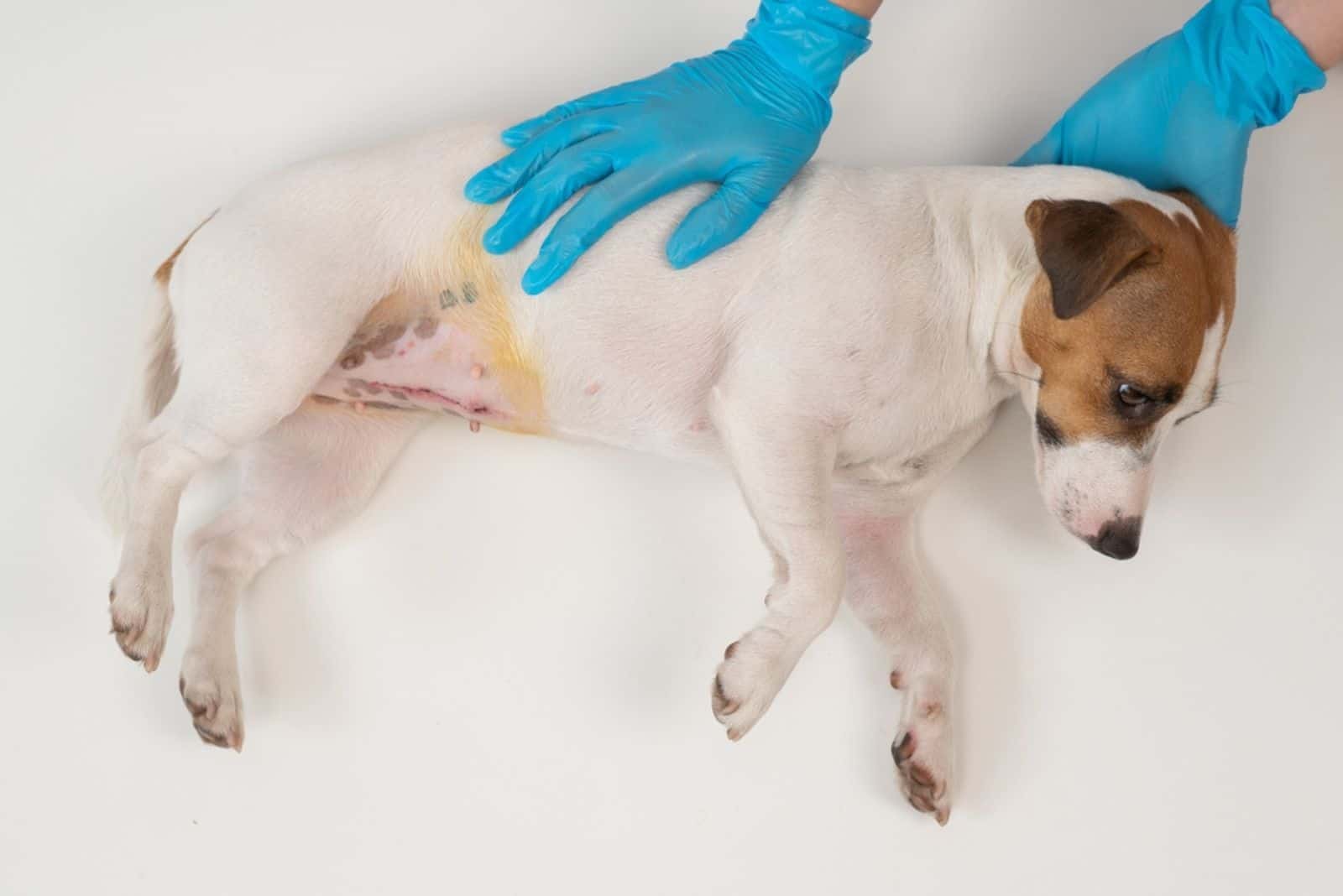Changes in our pets’ skin can surprise us and even scare us. Changes such as redness and rashes occur due to various causes and can appear in any dog, regardless of the breed.
If you have noticed black spots on dog belly, we believe you got quite scared. But, before you start panicking, it would be good if you were informed about the reasons for this phenomenon.
Black dots on your dog’s belly can occur due to various causes, which we will analyze in this text. We will also explain how to treat these changes on your pet’s skin, and when it is time to visit a veterinarian.
What Causes Black Spots On Dog Belly?
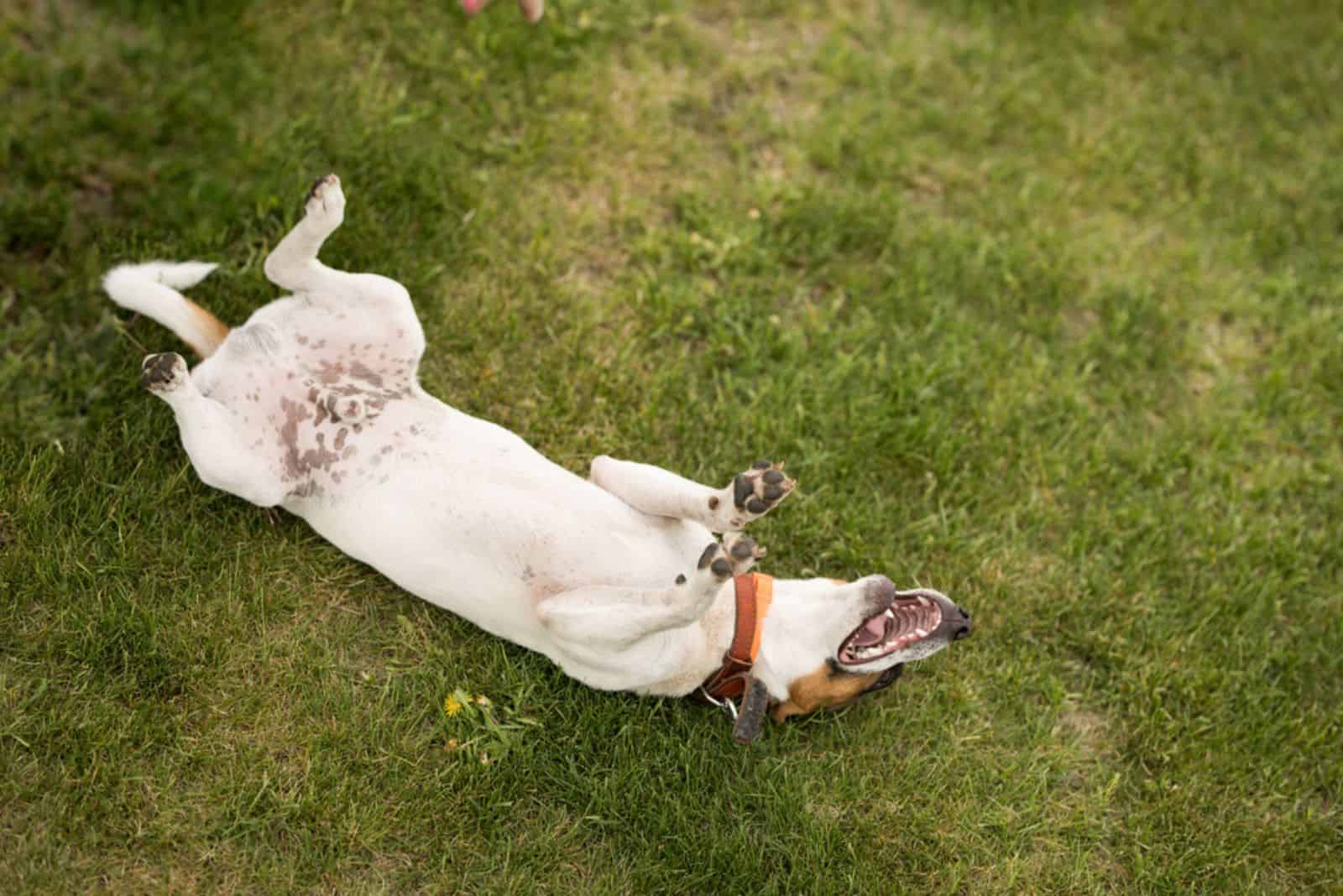
Black spots on dog belly will not appear without a concrete cause. Sometimes, the cause of this occurrence is not too severe, and your dog’s belly will look normal quite soon.
However, in some other cases, a certain underlying cause, or a more severe medical condition might cause black spots on your dog’s stomach.
The appearance of black spots on the dog’s stomach, that is, hyperpigmentation, is a reaction of the dog’s body to a certain condition. So, behind the hyperpigmentation on the dog’s stomach, an underlying condition has led to this consequence.
There are two types of hyperpigmentation in dogs – primary and secondary. Primary dog hyperpigmentation will be noticeable when the dog reaches one year of age, and it is especially attached to Dachshunds.
Secondary hyperpigmentation can occur in any dog, and is usually the result of some inflammation and occurs with other symptoms, such as hair loss, pain, and an unpleasant odor.
First, all pet parents should know the leading causes of this skin change in their dogs. So, let’s find out all about these causes.
1. Living Conditions
Does your dog have a special place where he sleeps, his own bed, or does he sleep anywhere? Does your pet spend much time in a dusty, closed space that is not ventilated often?
Believe it or not, this could cause black spots on your dog’s belly. Dog hygiene is just as important as human hygiene – of course, we don’t need to bathe our dogs every day, but we should definitely take care that they are clean.
Frequent bathing is not even recommended so not to strip the natural oils from our dogs’ coats, but this does not mean that you should go six months without bathing your dog!
Poor hygiene and the dog’s stay in dusty areas causes the accumulation of a large amount of secretions mixed with dust on the dog’s skin.
Over time, this leads to clogging of the follicles and pores of the dog’s skin, and as a result, black spots may appear.
2. Sun Exposure
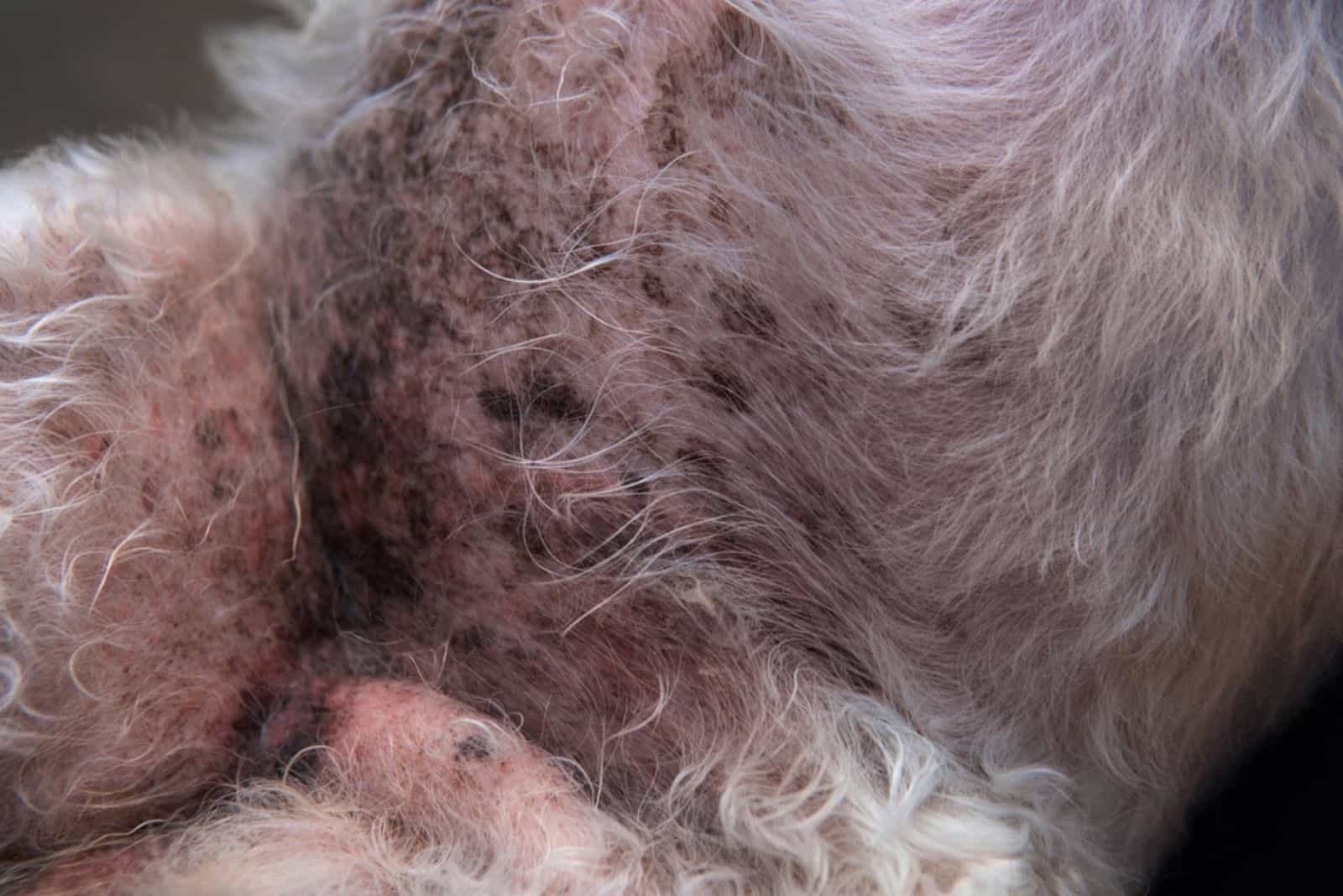
Many dogs like to lay in the sun; you have probably seen your pooch laying on his back in the yard, looking like he is having the time of his life.
This is actually true, since dogs, just like humans, are happier when they spend time in the sunlight. They like to feel warm outside and the sun affects their mood positively in general. However, frequent exposure to the sun might cause changes in the dog’s skin.
If you have noticed black spots on your dog’s belly, there is a big chance that he has spent too much time in the sun. This is not recommended, and can even lead to more severe health issues, such as overheating and heatstroke.
Hairless dog breeds and dogs with lighter coat colors are more likely getting sunburned.
So, you should not let your dog spend too much time in the sun, especially during hot summer months. Dog owners should walk their dogs early in the morning or late in the night, when it is not too hot outside.
If in some cases, you have no other choice, and your dog has to spend some time in the sun, remember to use sunscreen for dogs.
3. Yeast Infection
One of the unpleasant skin infections that our dogs can suffer from is the yeast infection, also known as Malassezia dermatitis.
If you notice hyperpigmentation on your dog’s stomach, it is possible that it is a fungal infection. In addition to the change in skin color, you may also notice that the dog’s skin flakes and that the dog loses hair on the infected part of the body. Furthermore, you will be able to recognize a yeast infection by a specific, cheesy odor.
If a fungal infection in a dog is not treated, it can spread throughout the body.
Before you notice yeast infection symptoms, your dog may be acting completely normal. However, perhaps already during this period, he is a carrier of yeast infection, and can infect other animals, and even people, in his environment.
Yeast infection can be transmitted by direct contact with an infected animal, or, for example, when two animals use the same feeding bowls or sleep in the same bed.
If you suspect your dog has a yeast infection, contact your veterinarian immediately. The treatment of this infection is based on the oral administration of antifungal shampoos and lotions.
4. Allergic Dermatitis
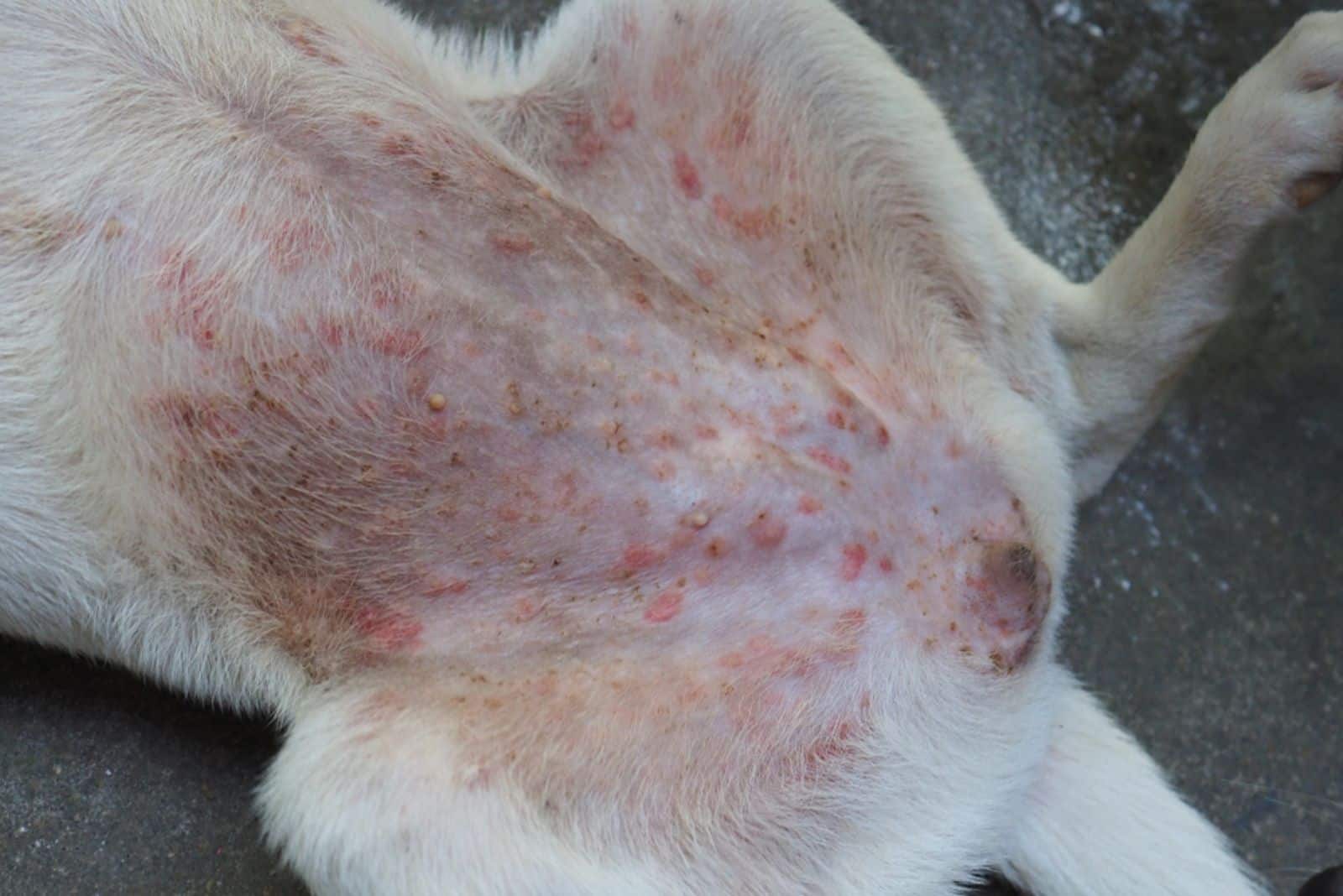
Black dots on your dog’s belly could indicate that your dog is having an allergic reaction, therefore, it is suffering from the allergic dermatitis, also known as the atopic dermatitis.
Allergens in dogs are various; thus, our furry friends can have allergies to food, but also to any ingredient from their environment, such as shampoo or cleaning agents, and pollen or some other allergen from nature.
To determine the presence of allergies in your dog, the veterinarian will perform an allergy testing. Some other symptoms of allergies in dogs, besides the black spots, might include itchy skin, coughing, sneezing, and swelling of the dog’s lips, ears, and face.
Some dog breeds that are prone to skin allergies are Labrador Retrievers, Lhasa Apsos, Pugs, and many Terrier dog breeds.
5. Mange
Black dots on the belly could be a sign that the dog has mange. This is a fairly common and easily transmitted disease in dogs, and it can be transmitted by direct or indirect contact. Humans can also be infected with mange, but, in general, this disease is easily treated in humans.
The mites that cause mange in dogs are called Sarcoptes scabiei. These parasites are most often present in stray dogs, dogs that do not have their own home and care, and they most often attack parts of the dog’s body that are not covered with hair, such as the stomach, the groin area, and armpits.
Mange can also be transmitted from cats to dogs and through infected brushes and other animal care tools.
You can notice the first symptoms in a dog only a few weeks after the dog is infected. The main symptom is intense itching and hair loss in the dog.
In addition, skin redness, skin rash, and the formation of small scabs on the skin that will fall off later, might appear. If mange is not treated, the red spots on the dog’s body can turn to dark patches.
The dog’s coat will have an unpleasant smell, and it is possible that secondary infections will occur because the dog’s immune system has weakened.
If you notice these symptoms in your dog,you must visit the veterinarian immediately. Through a detailed examination, the veterinarian will first establish whether it is an allergy or a bacterial infection, or whether your dog really has mange.
Learn more on how to get rid of mites on dogs.
6. Hypothyroidism

Hypothyroidism is an endocrine disorder that might cause the appearance of black dots on your dog’s belly.
In dogs, the thyroid gland is located in the neck and is one of the most important glands in the dog’s body. If the thyroid does not produce enough hormones, the dog’s metabolism will be slowed down.
The thyroid gland is vital because it produces hormones that control turning food into the fuel that drives a dog’s metabolism. If the thyroid is not working properly, all the organs of the dog’s body are at risk.
In addition to black spots on the body, additional symptoms of hypothyroidism in dogs are sudden obesity, lethargy, excessive shedding, ear and toenail infections, and hair loss. Dogs usually first lose their hair on the hind legs and their tails.
There is a higher chance that some dog breeds like Airedale Terrier, Cocker Spaniels, Doberman Pinschers, Schnauzers, and Irish Settlers will develop this disease.
Hypothyroidism is not completely curable, but we can control it with timely treatment. The treatment is carried out by oral administration of replacement thyroid hormone.
7. Cushing’s Disease
The hormone cortisol in dogs is produced in the adrenal glands, located in the abdominal cavity next to the kidneys.
Dogs suffering from Cushing’s disease, also known as Hyperadrenocorticism, have an increased secretion of cortisol, which harms organ function and the dog’s metabolism.
This disease in dogs occurs due to tumors of the pituitary gland or adrenal gland. Some dog breeds are more susceptible to this disease, such as Boxers, Dachshunds, Cocker Spaniels, and Poodles.
One of the first signs you can notice in a dog with Cushing syndrome is hyperpigmentation of the skin; therefore, if you have seen black spots on your dog’s belly, it may be Cushing’s disease.
In addition, the dog will likely drink more fluids, pee a lot, lose hair, and generally be very lethargic.
The veterinarian will determine whether your dog is suffering from Cushing’s disease based on blood tests, hormone checks, and ultrasound.
8. Advanced Age
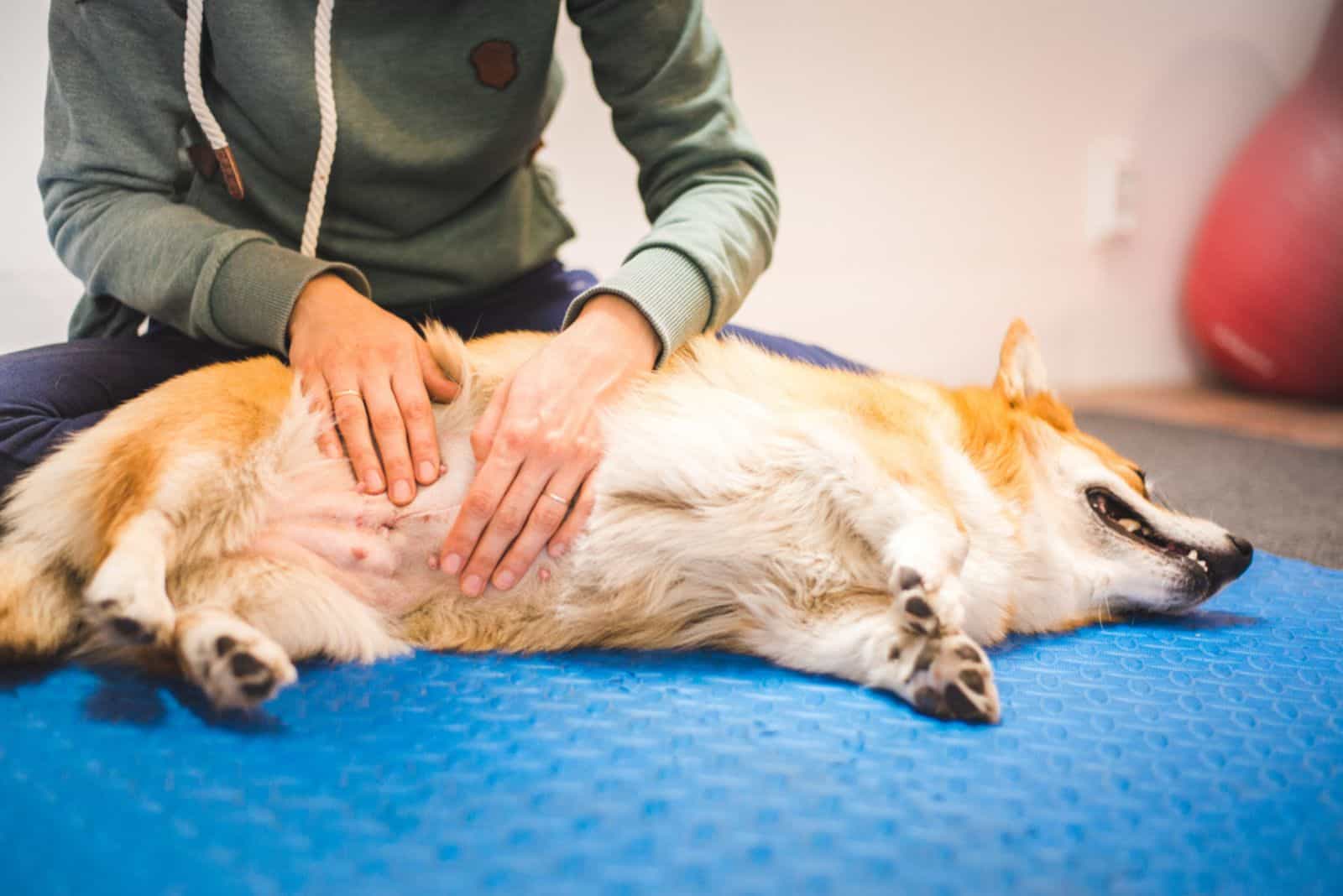
We don’t like the idea that our dogs will get old, but we have to deal with it. As time passes, you will notice clear signs that your dog is now a senior.
For example, you might notice that your pet is not energetic as it used to be, it might want to be alone more often, and it might seem lost and disoriented.
Also, you will notice your dog doesn’t look like he used to. The texture of a dog’s hair changes with age, so your dog’s fur can be significantly weaker as he ages. Various factors also affect the color of the dog’s fur, such as exposure to sunlight, diet, skin conditions, and consumption of medications.
You will probably notice a discoloration in your older dog’s skin. As the dog ages, melanin, or the pigment cells responsible for the color of the fur, stops being produced, and therefore the color of your dog’s fur changes color.
This is an entirely normal part of the dog’s natural aging process, and there is no way we can influence it.
9. Tumors
Unfortunately, in some cases, dark spots on a dog’s belly might indicate that the dog is suffering from a skin tumor. This cause is less likely to be the reason for dark spots from all the causes on our list, but still, we think it is good for dog owners to be informed on the topic.
If you have a short-haired dog, there is a high possibility that you will notice a skin tumor in him very early, while in long-haired dogs this will be a little more difficult.
Some symptoms that can occur in a dog with a tumor are pronounced fatigue, itchy skin, and the dog will often lick its body.
Tumors can be benign or malignant. If it is a malignant tumor, there is a high possibility that the tumor will grow quickly and that it will spread to other organs, while benign tumors grow more slowly and do not pose a greater danger to the dog’s health.
The treatment of a tumor in a dog will depend on the type of tumor, the stage of the tumor, as well as the place on the skin it has affected.
Therapeutic measures that veterinarians use in the treatment of skin cancer in dogs are immunotherapy, radiation, chemotherapy, and surgical removal of the tumor.
How Do You Treat Black Spots On Dogs Skin?
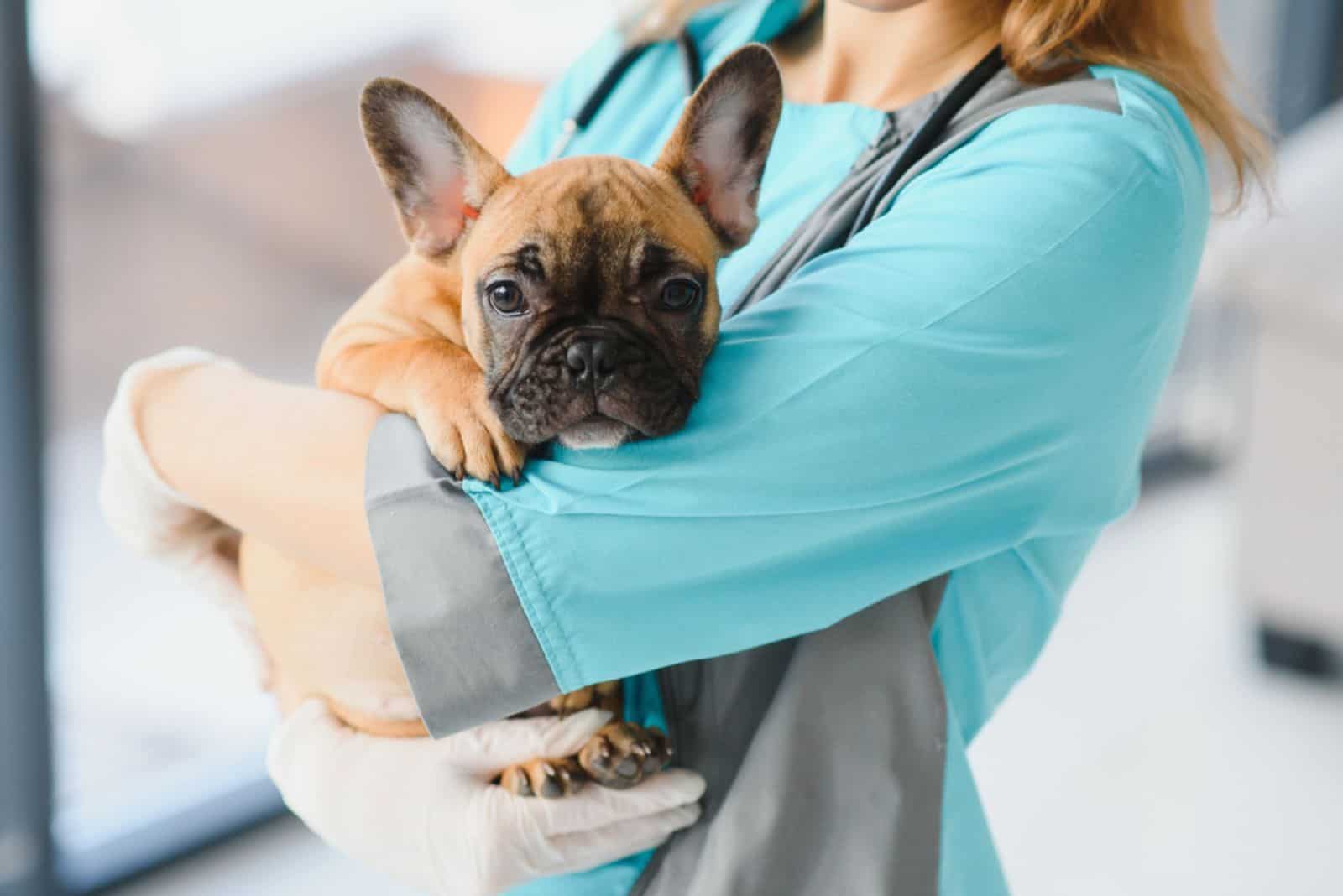
To treat black spots on dog belly, we first need to determine what causes these spots to appear.
Obviously, we need to take our dogs for a veterinarian examination, but, together with this, there are some additional steps all dog owners should undertake to ensure their dogs are living in a healthy and clean environment.
1. Take Care Of Your Dog’s Hygiene
Dogs should not live in dusty, non-ventilated spaces; this is bad for the dog’s health in general, and for their skin and coat, too. All dogs should spend certain time outside everyday.
Also, cleaning your dog’s belongings often, such as its bed, toys, and food and water bowls, is recommended.
Brushing and bathing your dog regularly is essential for maintaining dog’s hygiene. While brushing your dog’s fur, you can see whether there are any changes on its skin and coat and you also remove dirt and make its coat look fresh and smooth.
The frequency of bathing depends on the dog breed. For example, it is recommended to bathe a Golden Retriever once every six weeks, while a Shih Tzu should have a bath once every three to four weeks.
So, every dog owner should be aware of its dog’s hygiene needs and to plan its grooming schedule according to that needs.
Keeping our dogs and their environment clean prevents bacterial and yeast infections in them. Therefore, there is a smaller chance that you will be worried about dark spots on your dog’s belly.
2. Pay Attention To Your Dog’s Diet
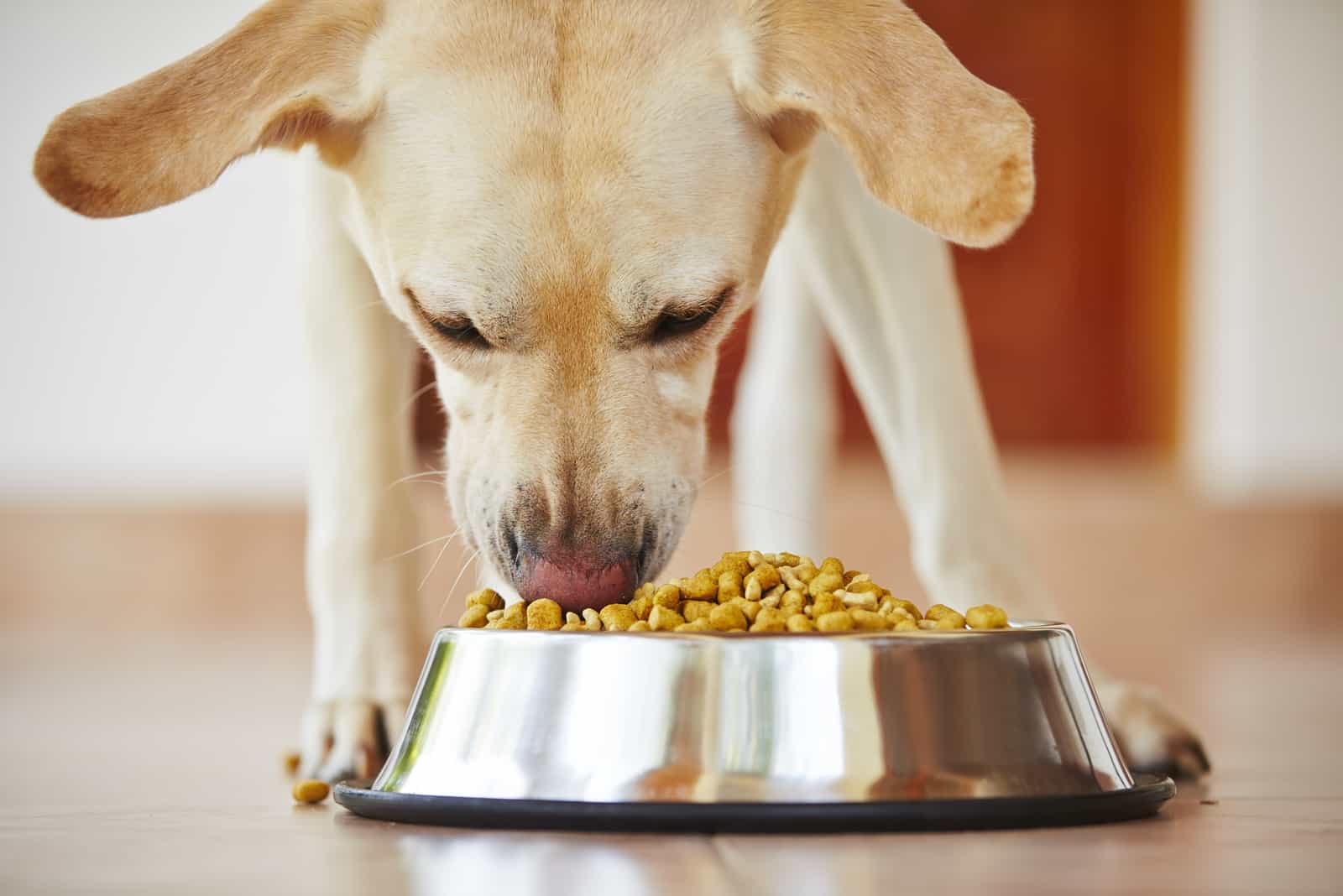
Allergies might cause black spots on the dog’s belly, and dogs might be allergic to certain food ingredients.
This is why dog owners should pay attention to dog food they choose for their pets. Just because a certain type of dog food is popular and you can see its advertisements wherever you go, this does not mean that the food will suit your dog.
All dogs are different and have different needs. If you used to have a dog and always fed him with a particular dog food brand, this can be different with your new pet.
If you notice black spots on your dog’s belly, or any other sign of allergic reaction, such as rash or dog’s intense scratching, you should immediately consider changing your dog’s diet.
If you are unsure how to do this, you should consult a veterinarian.
3. Do Not Expose Your Dog To Sun Without Protection
As we have seen, sun exposure might cause dark spots on your dog’s belly. Just like people, dogs can also get sunburned, so, all dog owners should avoid walking their dogs when it is hot outside.
How often we walk our dogs is essential for their health, but it is more important to ensure your dog will not get sunburned, or worse, have a heatstroke.
So, the best is to walk our dogs early in the morning. or late at night, so we avoid the parts of the day when the air temperatures are highest.
4. Consult A Vet
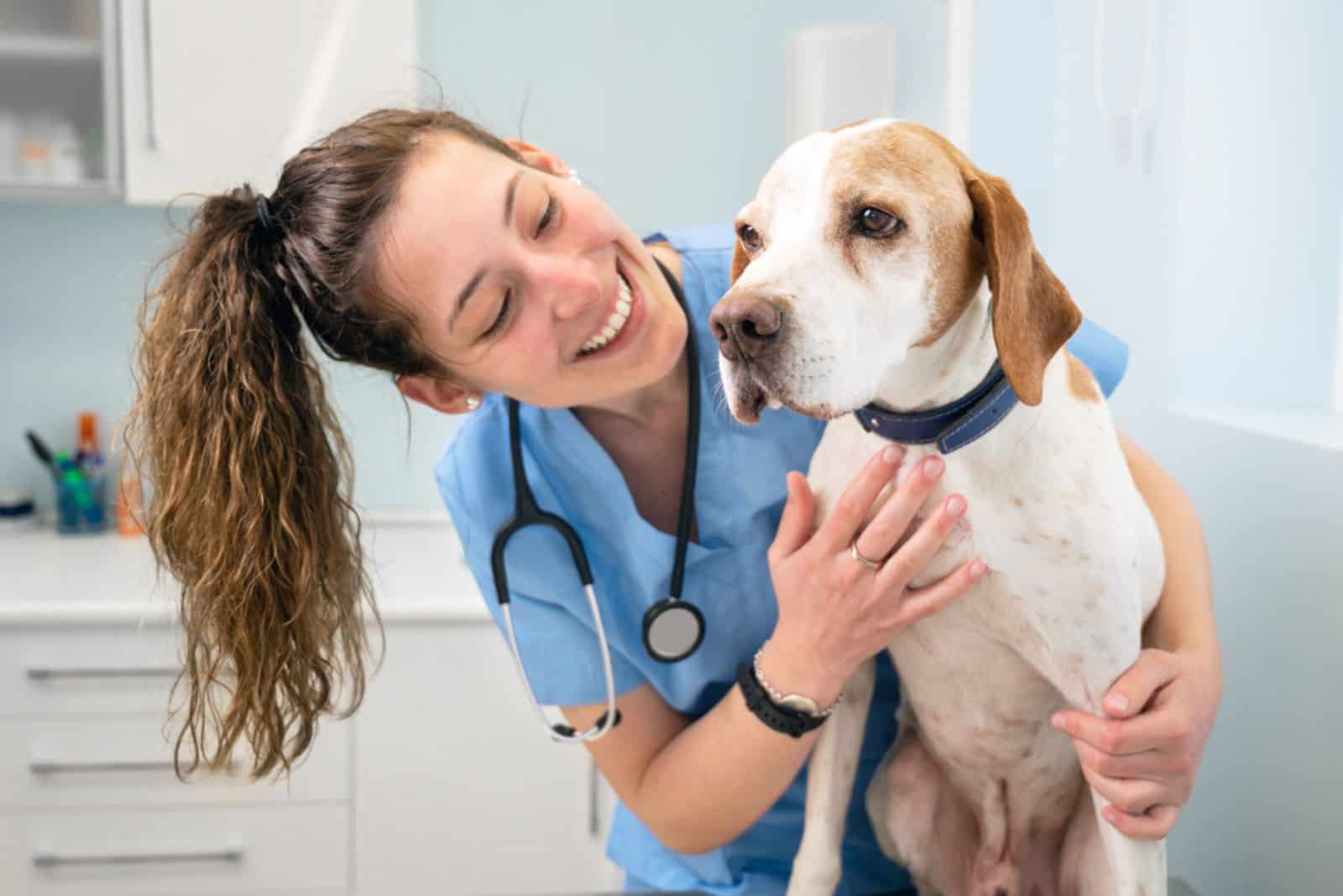
Black spots on a dog’s belly might appear due to an underlying skin condition, and this is why all dog owners should consult a vet as soon as they notice this change in their dogs’ skins.
In some cases, a cause might be harmless, but we don’t want to take our risks, do we? A veterinarian will determine the exact cause of this skin condition in your dog, and after that, he will prescribe an adequate treatment.
We want to remind all pet parents that they should not only visit a vet when they notice something strange is happening with their dogs.
All dogs should have an annual vet check-up; this way, even if your dog has a medical condition, you will notice it on time, and, therefore, your dog will have a higher chance for a full recovery!
Final Words
Dog’s skin is quite sensitive and all dog owners should be aware how essential it is to take proper care of it. Noticing black spots on dog belly might be surprising and intimidating, but, no matter what the cause is, it is crucial to be well-informed.
Some causes of dark spots on a dog’s body are less dangerous and dogs will recover from them in a couple of days or weeks. However, in some other cases, dark spots might indicate more severe medical conditions, such as Cushing’s disease or Hypothyroidism.
To help our dogs feel better, we first must determine the exact cause of the black spots on their bodies. The veterinarian will only help you do this, but you need to know the basics on this topic.
Therefore, we hope you have enriched your knowledge on black spots on a dog’s belly by reading this article!
Read Next:
• A White Spot On Dog’s Nose Requires Shampoo And A Hose
